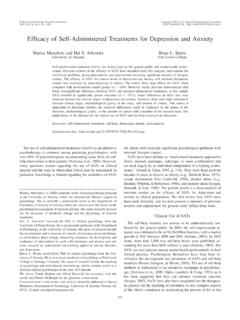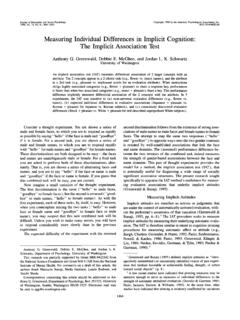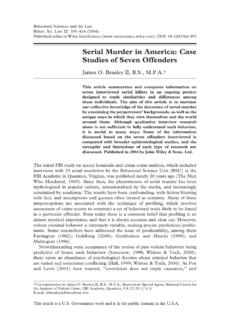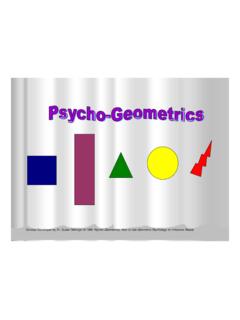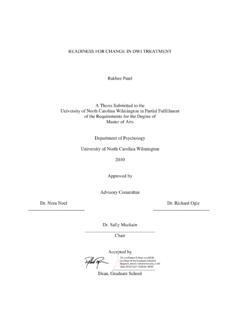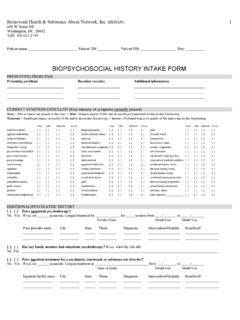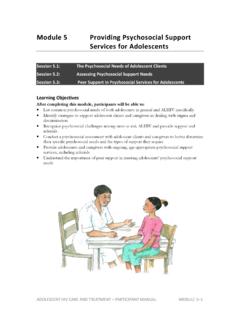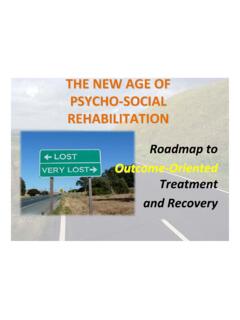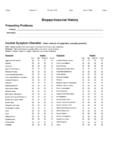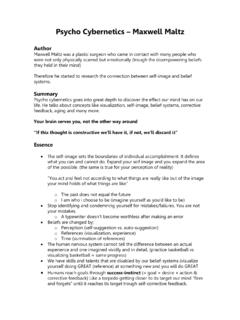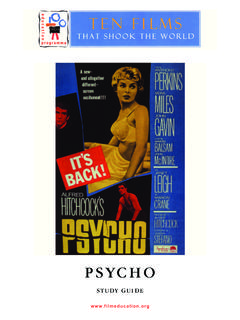Transcription of Outcome in Psychotherapy: The Past and Important Advances
1 Outcome in psychotherapy : The past and Important AdvancesMichael J. LambertBrigham Young UniversityFifty years after the 1963 debate between Strupp and Eysenck, as recorded in their articles inPsycho-therapy, it is clear that Eysenck overstated the case against psychoanalysis and dynamic psychotherapy (Bergin, 1971), while inflating the magnitude of improvement in untreated individuals (Lambert, 1976).Eysenck was probably correct about the beneficial effects of behavior therapies, but did not foresee thatbehavior therapy would be supplanted by cognitive behavior therapies (CBT) and eclectic mixtures ofCBT that incorporate elements of eastern religion, humanistic interventions, and psychodynamic con-structs.
2 Fortunately, most of the treatments that have been tested in rigorous investigations have beenfound to be effective, but few have distinguished themselves as uniquely superior. Many of the problemsof how to measure the effects of treatment have been solved and suggest that about two thirds of treatedindividuals improve or recover. This leaves a sizable portion of nonresponding individuals, but emergingmethods involving in tracking treatment response are being used to decrease deterioration and enhancepositive : psychotherapy Outcome , progress feedback, treatment effects, OQ-45In the first issue ofPsychotherapy,Hans Strupp (1963)wrote astimulating article that reflected issues of that time period, anauspicious beginning for this new journal.
3 His article was essen-tially a defense of the effects of psychoanalysis and related ana-lytic/dynamic, as well as eclectic treatments directed at the whollynegative evaluation of them byHans Eysenck (1952). Strupp wrotepersuasively about the ambitious goals of psychoanalysis, theexisting evaluations of it, and the degree to which psychoanalystsintended for the effects of their treatment to end with patientsbeing fully functioning individuals whose presenting symptomsdisappeared, who were self-understanding and accepting (of bothweaknesses and strengths), who were relatively free of talent-crippling inhibitions, and who could form and maintain satisfyingand lasting interpersonal relationships.
4 The degree of improvementin evaluations of patients was assessed by psychoanalytic thera-pists who saw patients four times a week over years and who, itcan be said, had rather extensive knowledge of their patients anda theoretical and common sense view of ideal mental emphasized the validity of psychoanalytic therapists viewsof their patients Outcome and strongly advocated for the effec-tiveness of psychoanalysis based on the scant literature next yearEysenck (1964)in a later issue ofPsychotherapyresponded to Strupp s advocacy and his own appraisal of theeffects of psychoanalysis and other psychotherapies reassertingthat there was no sound scientific evidence supporting psychoanal-ysis while advocating both tendencies for patients to heal them-selves and the success of behavior therapies.
5 At that point inhistory, existing studies had not randomly assigned patients totreatment versus no-treatment control groups, and Eysenck capi-talized on this fact to assert that patients could be expected toimprove over the same period of time without formal treatment that mental disorders were self-limiting and likely to subside overtime. InStrupp s (1964)rejoinder, he suggested that ample evi-dence documented the positive effects of psychotherapy and that itwas time to move on to more sophisticated questions (such ascomparative treatment effects), while also reiterating the impor-tance of broad views of patient benefit: To be sure, it is importantto free a patient from say a troublesome phobia, and everyonewould agree that symptom relief is asine qua nonin psychother-apy.
6 But, we must not lose sight of the patient s intrapsychicstate his sense of identity, feeling of worthwhileness as a person,and happiness (p. 101).In the context of the initial issue ofPsychotherapyand thedebate about the effects of psychoanalysis and psychodynamicpsychotherapies was the fundamental challenge that behavior ther-apy posed to psychodynamic thinking and procedures. The growthof learning-based approaches that appeared as early as the 1920s(Jones, 1924;Mowrer & Mowrer, 1938) had not had a dramaticimpact on psychotherapy until the publication of Wolpe sPsycho-therapy by Reciprocal Inhibitionin 1958.
7 But as Eysenck pointedout, behavior therapy appeared rather hopeful. Still the emergenceof cognitive therapy was a natural outgrowth of the limitations ofthe learning-based approaches, with their emphasis on behaviorat the expense of thought, but it also represented dissatisfactionwith the effects of psychodynamic treatments. Cognitive therapywas most notably advocated byEllis (1962)andBeck (1970)andcame to the forefront of theory-driven treatments by the mid1970swith the publication ofBeck s (1976)Cognitive Therapy and theEmotional and related developments, such as theemergence of social learning theory (Bandura, 1969)
8 , providedrich contrasts between cognitive theories and treatment methodsand carried with them a strong research course the debates over the accuracy of Eysenck s estimatesof both the outcomes of the verbal psychotherapies and those ofCorrespondence concerning this article should be addressed to MichaelJ. Lambert, PhD, Department of Psychology, 272 TLRB, Brigham YoungUniversity, Provo, UT 84602. 2013 American Psychological Association2013, Vol. 50, No. 1, 42 510033-3204/13/$ who did not receive any formal treatment went on forat least another decade, withBergin s (1971)comprehensive esti-mates of change following psychoanalytic psychotherapy (around85% for those that complete treatment) andLambert s (1976)reanalysis of spontaneous remission rates (around 40% improve-ment).
9 These narrative research reviews and many others sug-gested that the outcomes for treated individuals were substantial inrelationship to the passage of time. Perhaps one of the moreconvincing studies on the evidence presented by Eysenck waspublished byMcNeilly and Howard (1991)who used Eysenck sown data to demonstrate a 50% improvement rate in eight sessionsof psychotherapy as opposed to a 2% spontaneous remission rateover the same time period, and that patients get 2 years of symp-tom remission in only 15 sessions of psychotherapy than wouldhappen without Effects of psychotherapy : Current FindingsIn the ensuing years, evidence has mushroomed on a widevariety of older and newer forms of treatment.
10 A search of ISI Webof Knowledge (an Internet journal search engine) reveals thataround 60,000 academic articles have been published on psycho -therapy research in just the last 30 years. Much of the evidence forthe effects of psychotherapy has been summarized in variouseditions of theHandbook of psychotherapy and Behavior Change,now out in its 6th edition (Lambert, 2013a). Chapters in theHandbook are organized around systems and modalities of psy-chotherapy as well as special topics such as the therapist s contri-butions to Outcome and those of the client. We now have a massof well-designed scientific studies that neither Strupp nor Eysenckhad access to in 1963 and 1964 when they published their of older reviews, as well as newer meta-analyticreviews of psychotherapy Outcome , produce the broad finding oftherapy benefit across a range of treatments for a variety ofdisorders.

